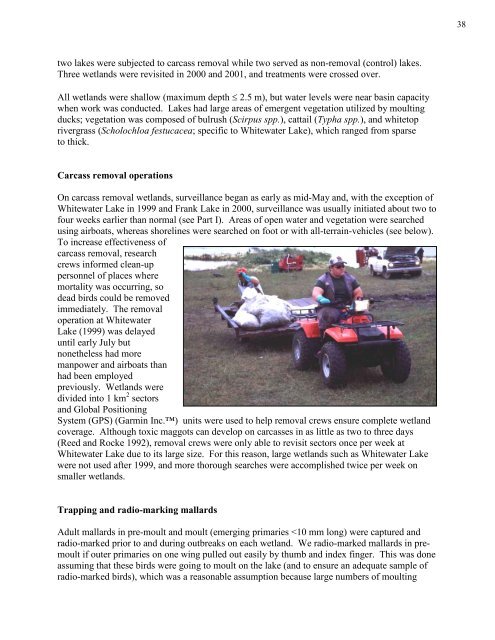Ecology and Management of Avian Botulism on the Canadian Prairies
Ecology and Management of Avian Botulism on the Canadian Prairies
Ecology and Management of Avian Botulism on the Canadian Prairies
You also want an ePaper? Increase the reach of your titles
YUMPU automatically turns print PDFs into web optimized ePapers that Google loves.
38two lakes were subjected to carcass removal while two served as n<strong>on</strong>-removal (c<strong>on</strong>trol) lakes.Three wetl<str<strong>on</strong>g>and</str<strong>on</strong>g>s were revisited in 2000 <str<strong>on</strong>g>and</str<strong>on</strong>g> 2001, <str<strong>on</strong>g>and</str<strong>on</strong>g> treatments were crossed over.All wetl<str<strong>on</strong>g>and</str<strong>on</strong>g>s were shallow (maximum depth ≤ 2.5 m), but water levels were near basin capacitywhen work was c<strong>on</strong>ducted. Lakes had large areas <str<strong>on</strong>g>of</str<strong>on</strong>g> emergent vegetati<strong>on</strong> utilized by moultingducks; vegetati<strong>on</strong> was composed <str<strong>on</strong>g>of</str<strong>on</strong>g> bulrush (Scirpus spp.), cattail (Typha spp.), <str<strong>on</strong>g>and</str<strong>on</strong>g> whitetoprivergrass (Scholochloa festucacea; specific to Whitewater Lake), which ranged from sparseto thick.Carcass removal operati<strong>on</strong>sOn carcass removal wetl<str<strong>on</strong>g>and</str<strong>on</strong>g>s, surveillance began as early as mid-May <str<strong>on</strong>g>and</str<strong>on</strong>g>, with <strong>the</strong> excepti<strong>on</strong> <str<strong>on</strong>g>of</str<strong>on</strong>g>Whitewater Lake in 1999 <str<strong>on</strong>g>and</str<strong>on</strong>g> Frank Lake in 2000, surveillance was usually initiated about two t<str<strong>on</strong>g>of</str<strong>on</strong>g>our weeks earlier than normal (see Part I). Areas <str<strong>on</strong>g>of</str<strong>on</strong>g> open water <str<strong>on</strong>g>and</str<strong>on</strong>g> vegetati<strong>on</strong> were searchedusing airboats, whereas shorelines were searched <strong>on</strong> foot or with all-terrain-vehicles (see below).To increase effectiveness <str<strong>on</strong>g>of</str<strong>on</strong>g>carcass removal, researchcrews informed clean-uppers<strong>on</strong>nel <str<strong>on</strong>g>of</str<strong>on</strong>g> places wheremortality was occurring, sodead birds could be removedimmediately. The removaloperati<strong>on</strong> at WhitewaterLake (1999) was delayeduntil early July butn<strong>on</strong>e<strong>the</strong>less had moremanpower <str<strong>on</strong>g>and</str<strong>on</strong>g> airboats thanhad been employedpreviously. Wetl<str<strong>on</strong>g>and</str<strong>on</strong>g>s weredivided into 1 km 2 sectors<str<strong>on</strong>g>and</str<strong>on</strong>g> Global Positi<strong>on</strong>ingSystem (GPS) (Garmin Inc.) units were used to help removal crews ensure complete wetl<str<strong>on</strong>g>and</str<strong>on</strong>g>coverage. Although toxic maggots can develop <strong>on</strong> carcasses in as little as two to three days(Reed <str<strong>on</strong>g>and</str<strong>on</strong>g> Rocke 1992), removal crews were <strong>on</strong>ly able to revisit sectors <strong>on</strong>ce per week atWhitewater Lake due to its large size. For this reas<strong>on</strong>, large wetl<str<strong>on</strong>g>and</str<strong>on</strong>g>s such as Whitewater Lakewere not used after 1999, <str<strong>on</strong>g>and</str<strong>on</strong>g> more thorough searches were accomplished twice per week <strong>on</strong>smaller wetl<str<strong>on</strong>g>and</str<strong>on</strong>g>s.Trapping <str<strong>on</strong>g>and</str<strong>on</strong>g> radio-marking mallardsAdult mallards in pre-moult <str<strong>on</strong>g>and</str<strong>on</strong>g> moult (emerging primaries


